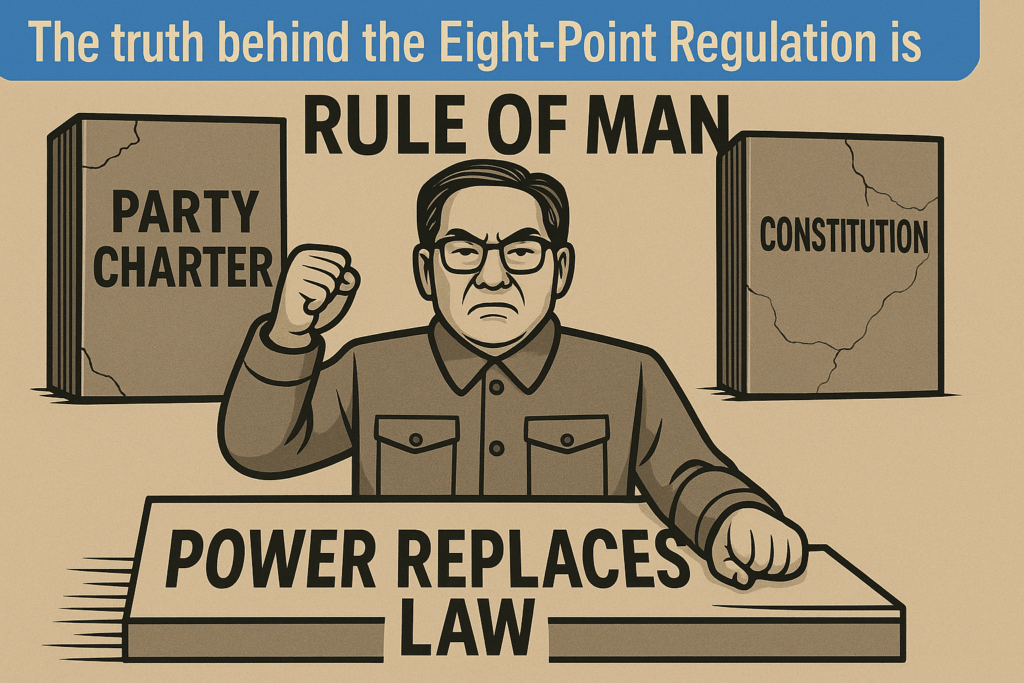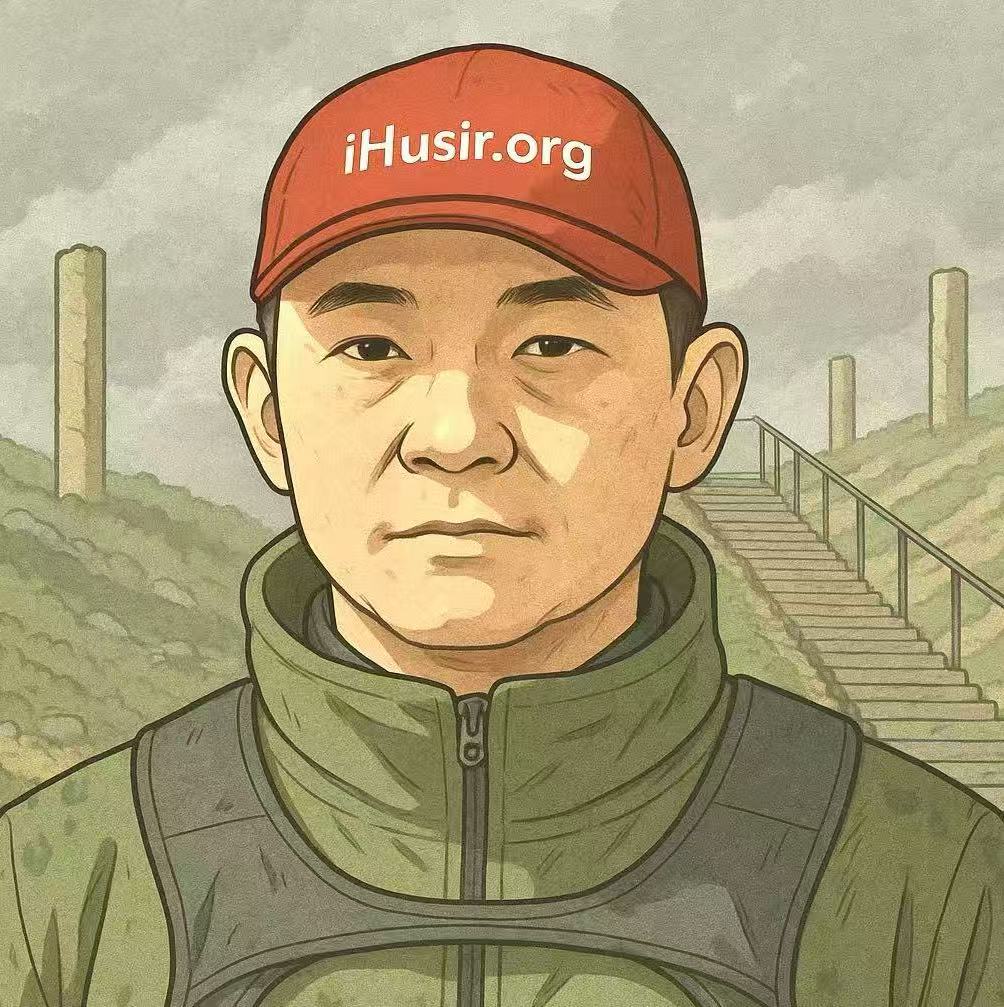文 / MingSir
导语摘要:
从“八项规定”出发,我们看到的不是制度的深化,而是人治的加固。当纪律成为选择性工具,制度让位于权力意志,总书记们提出的“理论创新”不再是改革的契机,而是体制滑坡的遮羞布。本文回顾建国以来历任领导人如何以理论名义重构制度,最终形成一个无法纠偏、拒绝异见、全面封闭的治理结构。制度若不守,再多的口号都是幻象。
一、“八项规定”的悖论起点
2012年末,习近平执政初期主推的“八项规定”被视为整肃党内作风、密切党群关系的一记重拳。它强调反对形式主义、官僚主义,精简会议、压缩开支,赢得了不少公众的好感,也为此后“全面从严治党”提供了行动模板。
然而,随着时间推移,这项原本意在“管住细节”的纪律规定逐渐被赋予更大的政治意义,并在实际操作中显示出选择性执纪、下重上轻、聚焦表象、回避根本的特征。一方面,许多基层干部因吃饭、送礼、公车使用等小节被查,另一方面,对于党章中明确规定的政治生活规范、集体领导原则、组织监督机制却避而不谈。
这种“外延小于内涵”的现象,逐渐演化成一种纪律压倒法治、规定凌驾党章的结构性失衡,标志着党内制度建设从“法治逻辑”再次滑向“人治逻辑”。

二、“理论创新”掩盖下的制度重构
建国以来,每一位中共中央总书记几乎都推出一套代表其执政风格和思想理念的“指导思想”,从“继续革命”到“科学发展”,再到“新时代中国特色社会主义思想”,这些理论在党章中被不断写入、在宣传中被不断放大,最终在权力运行中获得超越制度的地位。
这套路径的本质在于:通过“理论创新”的名义,将领导人个人意志制度化、权威化、全局化。理论被包装为时代需要,实则成为排斥异见、强化忠诚、延续个人主导权的合法外衣。
更严重的是,这些“理论”往往没有真正的反对者——不是因为人人信服,而是因为在党内等级绝对服从的权力结构中,异见者的意见无法上达,甚至可能遭到打压、审查、酷刑。所谓“党内民主”只是形式,所谓“多党合作”早已名存实亡,而党章中“集体领导”“组织监督”等原则也被边缘化为装饰。
三、总书记制度路径纵览:从毛到习
1. 毛泽东:群众路线与个人崇拜的结合
毛泽东以“反官僚、走群众路线”为起点,但最终通过“继续革命”将党章、宪法、组织程序一一置于个人意志之下。文革十年摧毁了制度基础,国家治理体系沦为个人权力表演的舞台。
2. 邓小平:改革务实与制度弱化并存
邓小平确立了经济优先和实用主义的路线,提出“依法治国”,但真正治理依然倚重人事控制、元老协调与“摸着石头过河”。他虽结束个人崇拜,却并未真正确立法治权威,制度依旧为领导意志让步。
3. 江泽民:“三个代表”与合法性再包装
江提出“三个代表”试图构建党的广泛代表性基础,但这套理论未能在制度制衡、民主监督方面带来结构性突破。其执政后期官僚主义横行、权贵资本勾连愈演愈烈。
4. 胡锦涛:“科学发展观”与软性人治
胡强调“以人为本”“党内民主”,试图在不破坏现有结构的前提下推进制度改革,但在“集体领导”内部机制掣肘下,政策呈现“维稳至上、逐级妥协”特征,改革意图难以落实为制度成果。
5. 习近平:“新时代思想”与结构性集权
习近平执政后提出“新时代中国特色社会主义思想”,主导“两个确立”,并通过“八项规定”、反腐行动及纪律整风工程,确立起纪律控制、思想统一、组织忠诚三位一体的治理结构。这是一种高度集中的个人权力体系,在名义上法治化、现代化,实质上是高度人治化的整合模式。
四、“制度”如何变成“统治技术”?
这种高度集中的人治结构表面看以制度为基础,但实质是以制度为工具。它呈现出以下几个特征:
1. 程序性服从压倒实质性公正:规定严格、制度密布,但关键事务往往靠“拍板”解决。
2. 纪律取代法治:违法行为可以不查,只要不“违反纪律”;而形式上的“不合规”却可成为打击异见的依据。
3. 宣传包装制度重构:“新时代思想”取代党章作为实践指导,组织生活被学习文件取代,批评与自我批评沦为空洞仪式。
4. 个人意志凌驾组织程序:重大人事决策、战略布局高度依赖领导人个人判断,形成事实上的“权威高于制度”的状态。
五、八项规定的象征性与实用性错位
八项规定本是“反形式主义、反官僚主义”的切入口,但由于其定位为“中央意志”的操作化表达,反而为整个制度构建了一种新的逻辑:只要符合“领导旨意”,即使绕开制度也是正当的;而不合领导思路,即使合规也可定罪。这种逻辑正在摧毁中国社会原本尚存的“有限法治希望”。
“八项规定”从一开始就被赋予了超出其实质内容的政治意义。它的象征价值——“反腐、正风、整顿纪律”——远大于其具体内容。随着政治权力的集中,它成为一种政治忠诚测量仪、政策服从度试金石,其运行逻辑早已脱离了制度建设本身。
而普通党员和公民所面临的现实是:再小的违规可被无情清算,再大的错误若属上意则无人追责。“制度”变成了一种“打击可控、豁免权贵”的双轨运行体系。
六、思想封闭与制度自毁
在这种结构中,最令人警惕的不是权力的集中本身,而是权力配合信息封锁和思想灌输的“全封闭循环”。所谓“核心讲话”“集中学习”“理论宣讲”“跟进贯彻”,成为一种全天候的信息覆盖机制。质疑被视为不忠,沉默被视为默认,独立思考几乎成为风险。
当一个政治系统既不能容纳异见、又不能纠错,当制度成为“高压合规”的工具而非“真实协商”的平台,那么它就失去了自我修复的可能性。这才是从“八项规定”出发,最终滑向制度溃败的深层危机。
七、结语:制度若不守,理论皆为幻象
制度之所以存在,不是为了赞美权力,而是为了限制权力;不是为了塑造光环,而是为了提供纠偏机制。如果制度本身被包装为“政治正确”的工具,成为服务于领袖意志的外壳,那么一切理论创新不过是新的个人崇拜,一切整风纪律不过是新的高压统治。
当“党纪”凌驾于“党章”,当“理论”遮蔽了“法治”,当“政治忠诚”胜过“制度责任”,我们就不该再对“制度现代化”抱持幻觉。
真正的政治文明,不在于理论多响亮,而在于是否能够容纳批评、纠正错误、限制权力并保护普通人。
真正的转变,必须回到“制度高于个人”的基本政治文明共识;否则,一切以整风之名的行动,最终都可能成为新的制度破坏手段。
这,才是制度存在的理由。
From “Eight-Point Regulation” to Institutional Erosion: The Deep Crisis in Top Leaders’ “Theoretical Innovation” and the Logic of Rule by Man
By MingSir
Lead-in Summary:
Starting from the “Eight-Point Regulation,” we see not the deepening of institutions but the consolidation of rule by man. When discipline becomes a tool of selective enforcement and institutions yield to the will of power, the “theoretical innovations” proposed by successive General Secretaries cease to be opportunities for reform and instead become fig leaves for systemic decline. This article reviews how, since the founding of the PRC, our leaders have reconstructed institutions in the name of theory, ultimately forming a governance structure that cannot self-correct, rejects dissent, and is completely closed. If institutions are not honored, then however many slogans are uttered, they remain mere illusions.
I. The Paradoxical Starting Point of the “Eight-Point Regulation”
At the end of 2012, early in his tenure, Xi Jinping rolled out the “Eight-Point Regulation,” hailed as a heavy blow against poor Party conduct and a means to draw the Party closer to the people. It emphasized opposition to formalism and bureaucracy, pruning meetings and expenditures. It won public approval and offered a blueprint for the subsequent campaign of “comprehensively enforcing strict Party discipline.”
Yet over time, this set of rules—originally aimed at “controlling the details”—came to carry outsized political significance. In practice it displayed selective enforcement: punishing minor infractions by grassroots cadres for banquets, gift-giving, or misuse of official vehicles, while glossing over the Party Charter’s clear mandates on political life norms, collective leadership, and organizational oversight.
This phenomenon—where the external scope of the regulation shrinks below its internal spirit—evolved into a structural imbalance in which discipline overrides the rule of law and these specific provisions trump the Party Charter. It marks a renewed slide in intra-Party governance from a “rule-of-law logic” back toward a “rule-by-man logic.”

II. Institutional Reconstruction Under the Guise of “Theoretical Innovation”
Since 1949, each General Secretary of the CPC Central Committee has introduced a set of guiding doctrines reflecting his governing style and ideological vision: from “Continuing the Revolution” to “Scientific Development,” all the way to “Xi Jinping Thought on Socialism with Chinese Characteristics for a New Era.” These theories have been progressively written into the Party Charter and magnified through propaganda, eventually attaining a status in the exercise of power that supersedes formal institutions.
The essence of this trajectory is clear: in the name of “theoretical innovation,” the personal will of the leader is institutionalized, made authoritative, and universalized. Theory, packaged as necessary for the times, in truth functions as a legitimate veneer for suppressing dissent, demanding loyalty, and perpetuating personal dominance.
Even more troubling, these theories often lack genuine internal opponents—not because everyone agrees, but because in a power structure demanding absolute top-down obedience, dissenting views cannot reach the top and may even face repression, censorship, or torture. What passes for “intra-Party democracy” is little more than a façade; what is called “multi-party cooperation” has long since become a rubber stamp. The Party Charter’s principles of “collective leadership” and “organizational supervision” have been marginalized into mere decoration.
III. A Historical Survey of General Secretaries’ Institutional Paths: From Mao to Xi
1. Mao Zedong: The Fusion of the Mass Line and Cult of Personality
Mao began with “opposing bureaucracy and mobilizing the masses,” but under the banner of “Continuing the Revolution,” he placed the Party Charter, the Constitution, and organizational procedures all under the sway of his personal will. The ten-year Cultural Revolution destroyed the institutional foundation and turned the state’s governance system into a theater for personal power displays.
2. Deng Xiaoping: Pragmatic Reform and the Persistence of Weak Institutions
Deng set economic development as paramount and introduced pragmatism with “rule by law,” yet real governance still relied heavily on personnel control, senior-elders’ coordination, and trial-and-error policies. Although he ended the personal cult of personality, he did not genuinely establish the supremacy of the rule of law; institutions continued to yield to leadership will.
3. Jiang Zemin: “Three Represents” and the Repackaging of Legitimacy
Jiang’s “Three Represents” attempted to broaden the Party’s representative base, yet failed to achieve structural breakthroughs in checks and balances or democratic oversight. During his tenure, bureaucratism ran rampant and elite-capital collusion intensified.
4. Hu Jintao: “Scientific Outlook” and Soft Rule-by-Man
Hu emphasized “people-centered” development and “intra-Party democracy,” aiming to advance institutional reforms without dismantling existing structures. But the constraints of “collective leadership” produced a policy style marked by “stability above all, compromise at every level,” and reform efforts rarely translated into substantive institutional achievements.
5. Xi Jinping: “New Era Thought” and Structural Centralization
Xi has articulated “Xi Jinping Thought on Socialism with Chinese Characteristics for a New Era,” led the “Two Establishes,” and enacted the “Eight-Point Regulation,” anti-corruption campaigns, and disciplinary rectification drives. He has cemented a governing structure of discipline control, ideological unity, and organizational loyalty. While nominally rule-of-law and modernized, in reality this is a highly rule-by-man integrated model.
IV. How “Institutions” Become “Techniques of Domination”
This highly centralized structure of rule by man may appear to rest on institutions, but in truth it uses institutions as tools. It manifests in four key features:
- Procedural Obedience Over Substantive Justice: Rules are stringent and institutions dense—but critical decisions rely on “top-down edicts.”
- Discipline Replacing Rule of Law: Wrongdoing can go uninvestigated if it does not “violate discipline”; conversely, mere procedural lapses can be grounds for crushing dissent.
- Propaganda Repurposing of Institutions: “New Era Thought” has replaced the Party Charter as the guide for practice; organizational life is supplanted by study sessions of official documents, and criticism and self-criticism have become hollow rituals.
- Personal Will Superseding Organizational Procedures: Major personnel and strategic decisions depend heavily on the leader’s personal judgment, creating an environment where “authority trumps institutions.”
V. The Symbolic-Pragmatic Disjunction of the Eight-Point Regulation
From its inception, the Eight-Point Regulation served as an ostensibly narrow corrective against formalism and bureaucracy, yet its role has been elevated to the status of the embodiment of central political will. It has become a gauge of political loyalty and policy compliance. Once political power concentrates, the Regulation’s symbolic value—“fighting corruption, rectifying style, enforcing discipline”—far exceeds its substantive content.
Ordinary Party members and citizens find themselves in a reality where the smallest infractions are mercilessly punished, while the gravest errors, if sanctioned by higher-ups, escape any accountability. Institutions become a dual-track enforcement system: controlled to suppress undesired elements, but lenient when it comes to privileged elites.
VI. Intellectual Closure and Institutional Self-Destruction
In this structure, the greatest danger is not power concentration per se, but rather the closed-loop combination of power, information censorship, and ideological indoctrination. The nonstop cycle of “core speeches,” “concentrated learning,” “theoretical lectures,” and “implementation follow-up” forms an all-encompassing information cover. Questioning is deemed disloyalty, silence is taken as consent, and independent thought becomes a risk.
When a political system can neither accommodate dissent nor correct errors—when institutions become tools of “high-pressure compliance” rather than platforms for genuine consultation—it loses any capacity for self-repair. This is the deep crisis that begins with the Eight-Point Regulation and ends in systemic failure.
VII. Conclusion: Institutions Unprotected, Theory an Illusion
Institutions exist not to glorify power, but to limit power; not to craft halos, but to provide mechanisms for correction. If the institution itself is packaged as a tool of “political correctness” and serves only the will of the leader, then all “theoretical innovations” amount to no more than a new cult of personality, and all disciplinary drives degenerate into high-pressure control.
When “Party discipline” trumps the “Party Charter,” when “theory” obscures the “rule of law,” and when “political loyalty” outstrips “institutional responsibility,” we must abandon any illusion of “institutional modernization.”
True political civilization does not hinge on how grand the rhetoric, but on whether it can accommodate criticism, correct mistakes, restrain power, and protect ordinary people.
Real transformation demands a return to the fundamental consensus that “institutions must stand above individuals.”Otherwise, every corrective campaign in the name of “rectifying style” risks becoming yet another means of institutional destruction.
This is the very reason institutions exist.
~~~*~~~
请填写您的邮箱,免费订阅作者最新文章。

发表回复